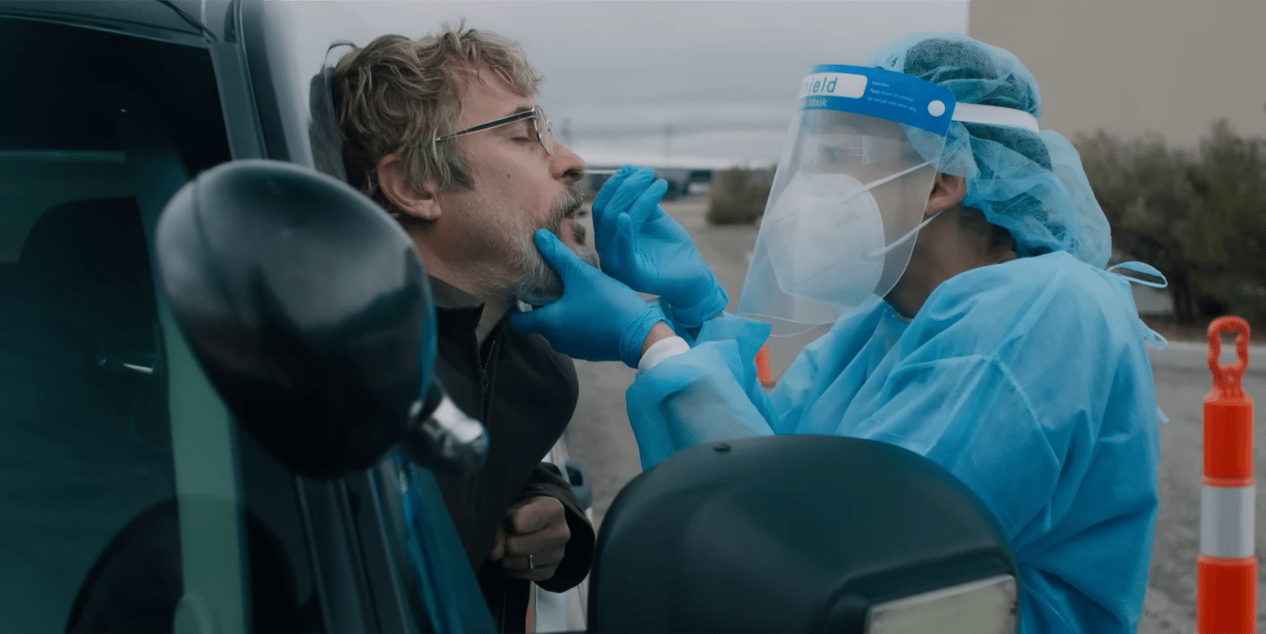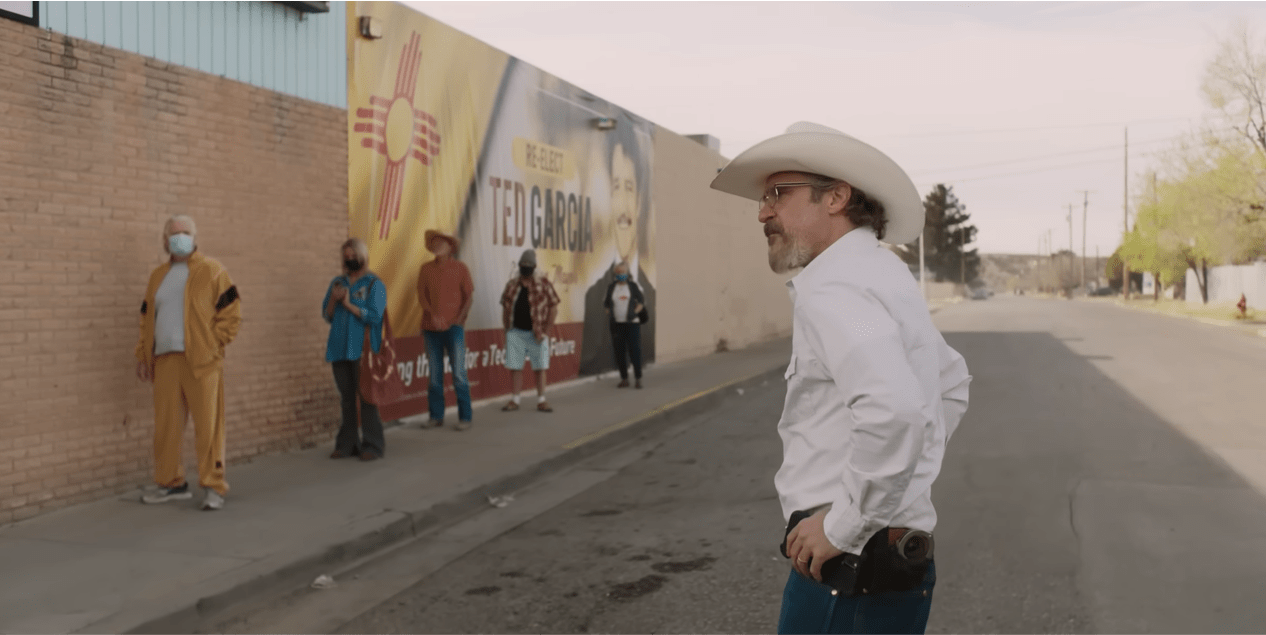Helmed by Ari Aster, ‘Eddington’ brings forth the effects of the COVID-19 pandemic through the eyes of two conflicting figures of power in the eponymous town: the sheriff, Joe Cross, and the town mayor, Ted Garcia. With a lockdown enforced and a strict mask mandate in place, opinions drift apart on a neighborhood-to-neighborhood basis, and before long, the entire town is up in arms. In the face of popular unrest, Cross makes the bold decision of running for Mayor, and gets engulfed in a seemingly never-ending stream of conspiracies and violent episodes, one that unveils many hidden flaws in the social structures he and his peers have come to uphold. This western drama movie employs a blend of black comedy and horror to shine a light on a myriad of contemporary issues, and taps into the very pulse of the homeland’s social consciousness in the process.
Eddington Partially Draws its Premise From a Real Small Town Feud in New Mexico
Written and directed by Ari Aster, ‘Eddington’ attempts to capture the numerous sociopolitical developments that occurred in rapid succession in 2020, with the COVID-19 pandemic serving as the narrative’s unifying thread. To that end, much of Aster’s tableau can be traced back to real landmark events, with some real-life figures potentially informing some of the characters. In a conversation with Variety, Aster stated that the core premise of the movie, about a conflict between a small-town sheriff and mayor, is partially inspired by a similar stand-off that took place in New Mexico during the COVID-19 era. He described the town as a “vast county with a small population,” where the sheriff and mayor had conflicting takes on subjects such as COVID-19 mandates. As such, Aster likely used this detail as a base for his dramatized account of a town feud, one that distills several contemporary anxieties into the mix.

A huge chunk of the narrative and visual identity of ‘Eddington’ is tied to the eponymous fictional town. Aster explained his desire to frame the place as a microcosm for the homeland, combining the many minor inspirations he had gathered while traveling and researching for the film. However, his creative rendition of Eddington was deeply informed by his life in New Mexico. Aster stated, “I’ve always wanted to make a film about New Mexico. I grew up there. My family still lives there. I know New Mexico probably better than any other place (…) When I came back to rewrite the script (of Eddington), I went back out to New Mexico, drove around the state, and went to different small towns to talk to police and mayors. I went to different counties to talk to sheriffs, went to pueblos.” Additionally, the director described himself as a hypochondriac, which suggests that a portion of the movie was also inspired by his own struggles and fears during the pandemic.
Eddington Recreates the Chaos of Year 2020 Through its Invented Story
On being asked about the creative engine behind his work in ‘Eddington,’ Aster recalled his central question as, “How can I make a film about the incoherent miasma we’re living in without the film becoming a message?” Through this approach, the film references several major developments from 2020, while still presenting them in a balanced light. While the bulk of the narrative centers on the reactions to the pandemic, with a specific focus on conspiracy theories surrounding masks, the movie also closely examines how Black Lives Matter activism has revolutionized the homeland’s zeitgeist. The story also offers a unique commentary on artificial intelligence networks and data centers, which began to gain popularity around the same time. The social and economic intersections between these diverse, complex subjects are at the heart of the movie.

Aster has also not shied away from reimagining the use of social media in the modern realm and has extensively discussed its mixed impact on society. In an interview with MovieWeb, he stated, “I think social media is a tool, and I think it’s been harnessed. And I think in a lot of ways we’ve been distracted by these ideological battles while big power operates above us and is changing us, changing the world.” This point is deeply connected to the story’s larger thematic conversation and thus gives it a timeless edge. Although the movie itself is set in 2020, its social and digital commentary is universally relevant and informed by Aster’s understanding of popular culture beyond the scope of the narrative.
Ted Garcia is Loosely Modeled After a Real New Mexico Mayor
The mayor of Eddington, Ted Garcia, is partially based on Nathan Dial, the real-life mayor of Estancia, a town in Torrance County, New Mexico. As Ari Aster has maintained that the character is based on a real figure from The Land of Enchantment, this connection is not far-fetched, as numerous details further strengthen the overlap. To begin with, Nathan Dial is listed under special thanks in the end credits of the movie, which aligns with the director’s claim that some of the people he was inspired by came to the set to consult. However, Nathan’s parallels with Ted Garcia run much deeper, as he is reportedly known for his long-standing conflict with the town’s sheriff, David E. Frazee. The similarities between this dynamic and the one mentioned by Aster are clear as day, making Nathan the most likely source of inspiration for the film’s mayor.

In his interview with Variety, Aster recalled a specific incident surrounding the mayor he was inspired by, which he described as, “The mayor was a really interesting guy who, before he ran for mayor, went to town hall with a gun on his person, and he was ejected from town hall. He ran on a platform of, “I’m going to make it so that if you come to town hall, you have to have a gun.” It is likely that Aster was referencing the real-life incident in Nathan Dial’s life, who reportedly took to the New Mexico Capitol on January 15, 2019, to protest against the state’s gun regulation rules. Although there is no similar scene in the film itself, the connection with Aster’s account only cements Nathan Dial as the reference point for Ted Garcia in ‘Eddington.’ However, Garcia’s personal life and narrative arc lay the groundwork for certain dissimilarities with his real-life counterpart; thus, it is equally likely that the character is a composite of several mayors Aster talked to during his research.
Read More: Delhi Crime’s True Story: Is Noor Based on a Real Baby? What Happened to Baby Falak in Real Life?


You must be logged in to post a comment.